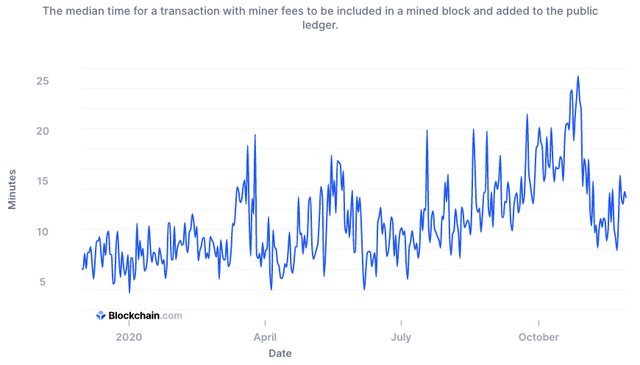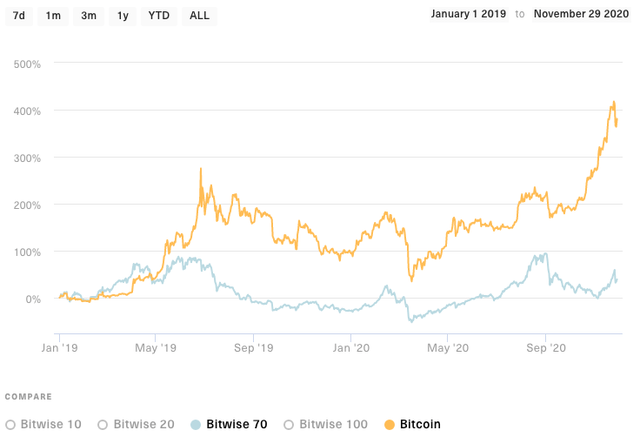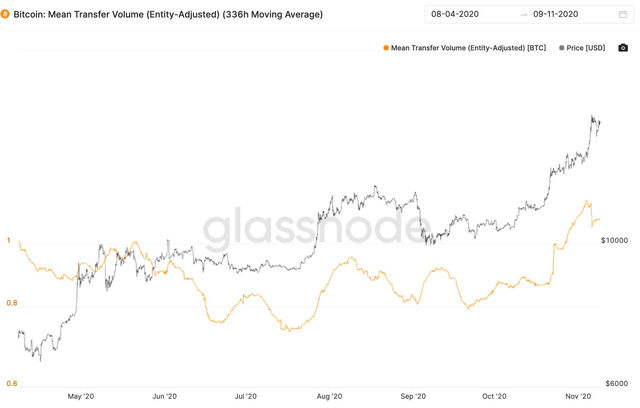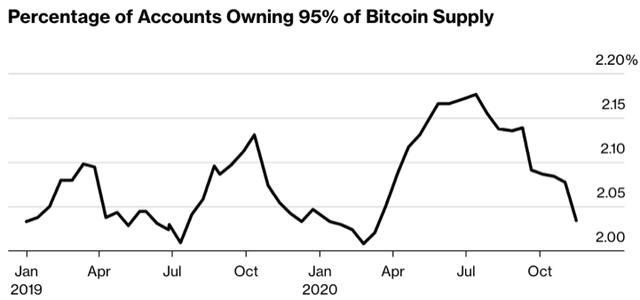Bitcoin (BTC-USD) has been on a tear, rising from about US$10,500 at the start of October, to a peak of US$19,129 on 24 November, a whopping 82% increase in the span of less than two months. This has had many investors wondering – is the cryptocurrency back with a vengeance? And is this the next big rally?
I started looking at Bitcoin pretty early on during the rally of 2017, thanks to a friend who was involved in the space (working for a crypto payments company). He told me all about the benefits of cryptocurrency – the decentralization on the blockchain, anonymity, ease of accessibility especially for the global unbanked population, elimination of banks as intermediaries, lack of cross-border barriers, the periodic halving of rewards, and so on.
Indeed, this all sounded great at first glance, but as I continued to research on the subject, I realized there were some major fundamental flaws with Bitcoin. These flaws have been discussed widely, but bear repeating here.
Essentially, for a cryptocurrency to be useful, it should be either i) an efficient medium of transfer or ii) a good store of value. Bitcoin was none of those. In terms of being an efficient medium of transfer, Bitcoin’s transaction fees (about $4USD per transaction currently) and the median confirmation time of about 13 minutes make it a poor tool for transactions, especially the lower-value ones that dominate our daily lives, which require near-zero fees and instantaneous confirmation. Meanwhile, its price volatility excludes it from being a good store of value – one need only look back to the one-day freefall of 27% on March 12th this year, compared to a 6% decline in the S&P on that same day. Granted, that was the peak of the coronavirus market crisis, and all asset classes were in freefall, but Bitcoin’s intra-day volatility far eclipsed that of other asset classes.
Chart: Bitcoin average transaction fee in USD
Source: YCharts
Chart: Bitcoin median transaction time in minutes
Source: Blockchain.com
Thus, I began investing in Altcoins – smaller market cap cryptocurrencies that incorporated technologies meant to overcome the shortcomings of Bitcoin. That served me well for a time, until the big crash in 2018. Luckily, I managed to take profit and get out while I was still decently in the black, but I’ve been sitting on the sidelines since.
Why? I learnt one important lesson about cryptocurrencies from the 2017-2018 cycle and the subsequent rebound since then: fundamentals don’t matter. There are a plethora of Altcoins with better technology than Bitcoin out there, yet the outmoded behemoth of the cryptocurrency world has outperformed the small-cap space by almost 10x since the trough of the market in January 2019. This trend also applies to the recent rally since the beginning of October 2020, where Bitcoin has outperformed the small-cap space by a factor of 6.6x over the roughly two month period. My takeaway from these price trends is as follows: if I can’t generate alpha based on research and analysis of fundamental differences between cryptocurrencies, then I’m not investing.
Chart: Bitwise 70 (representing the 70 largest small-cap cryptocurrencies) has massively underperformed Bitcoin since Jan 2019
Source: Bitwise
But taking this one step further – what could be behind the huge rally in Bitcoin? I believe it is the potent mix of i) sustained brand name popularity and ii) increasingly disproportional ownership in the asset. Essentially, a small number of ‘whales’ are able to crowd out the market and move prices disproportionately, and these price swings then tend to attract many retail investors who think ‘Bitcoin’ whenever the word ‘cryptocurrency’ is mentioned to participate in the rally, broadening the upswing. Whales can then choose to take profit at these higher levels.
This type of activity is relevant to the current rally because various metrics point to whales driving the rally. First, the average transfer volume of Bitcoin has spiked since the start of October, meaning that large trades are skewing the market.
Chart: Bitcoin mean transfer volume
Source: Cointelegraph
Second, the proportion of accounts holding 95% of Bitcoin by value has again fallen to trough levels of 2%, meaning ownership concentration amongst whales has increased.
Chart: Concentration of Bitcoin ownership
Source: Bloomberg
As a comparison to illustrate how highly concentrated the Bitcoin market is, here’s a quote from the New York Times in 2018, detailing their concerns about the concentration of ownership of equities in the US:
“A whopping 84 percent of all stocks owned by Americans belong to the wealthiest 10 percent of households. And that includes everyone’s stakes in pension plans, 401(NYSE:K)’s and individual retirement accounts, as well as trust funds, mutual funds and college savings programs like 529 plans.”
If these levels of equity ownership are concerning, surely the distribution of Bitcoin ownership should be much more concerning. Yet, constant newsflow around the Bitcoin rally only serves to lure in investors feeling the FOMO. I think there should be another meaning to FOMO: Fear of Massive Overhype!
Take some profits if invested, or look elsewhere if you aren’t yet
In summary, Bitcoin is actually a low quality cryptocurrency in terms of its technology meeting the objectives of a digital currency, and its value is derived mainly from investor’s familiarity with the name. Whales dominate the market, causing large price swings both ways, and such whale activity seems to be the driver behind the recent rally. It’s obviously difficult to say when the rally has gone too far, but think of it from the perspective of a Bitcoin whale. Given that prices have rallied back to 2017 highs, and are up 10x from the troughs of despair in 2019 and 145% year-to-date, would you start to take profits? I would. Retail investors should anticipate such a move and act in advance.
For those who are not yet invested, my recommendation would be to avoid Bitcoin, especially at today’s prices. Indeed, I believe that alpha generation on the back of fundamental research of any cryptocurrency is a wild goose chase, and I am not a fan of the asset class overall. Having said that, for those who want cryptocurrency exposure as part of a larger portfolio, you can consider other large-cap alternatives such as Litecoin (LCC-USD), Ethereum (ETH-USD) or Ripple (XRP-USD). These cryptocurrencies each have their own differentiating factors, are amongst the top 10 in terms of market cap, and yet have not rallied as much as Bitcoin from the January 2019 lows.
Lastly, remember that cryptocurrency is the wild west of investing, and while huge gains can be made quickly, don’t bit off more than you can chew and invest responsibly!
Disclosure: I/we have no positions in any stocks mentioned, and no plans to initiate any positions within the next 72 hours. I wrote this article myself, and it expresses my own opinions. I am not receiving compensation for it (other than from Seeking Alpha). I have no business relationship with any company whose stock is mentioned in this article.




